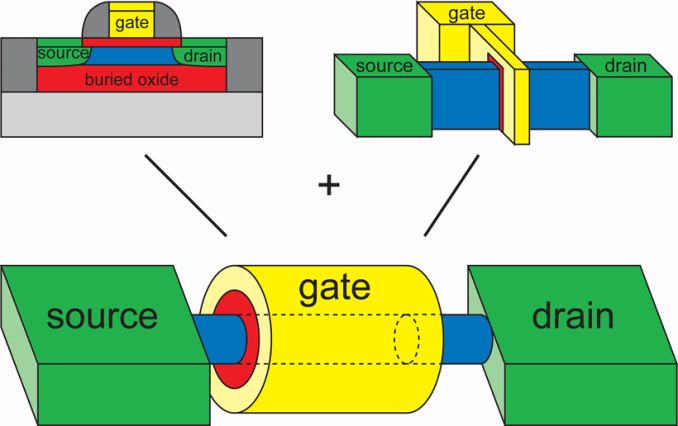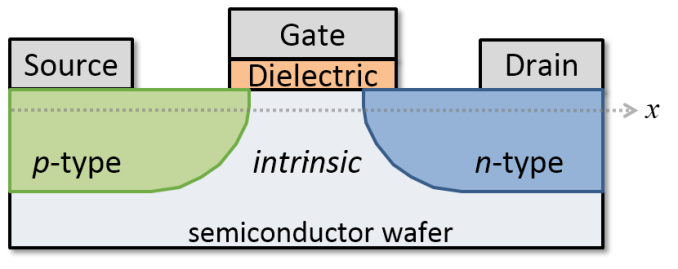An Introduction to Semiconductor Physics, Technology, and Industry
by Joshua Ho on October 9, 2014 3:00 PM EST- Posted in
- Semiconductors
- CMOS
- Physics
- Industry
- Technology
Improving Transistor Performance
While it's impossible to predict what the future will hold, it's relatively easy to see what trends will take place in the near future to keep Moore's law alive. For example, instead of using dual or tri gate technologies (FinFET), it's reasonable to expect that gate-all-around (GAA) will become the next step in the evolution of transistor shapes. However, it's currently not clear when this would reach mass production, if ever.
Currently, experimental GAAFETs have only existed for around eight years. For reference, FinFETs were first made in 1999. It took around a decade and a half for any such 3D transistor to reach mass production. By continuing to scale to higher k dielectrics for the gate, lower k dielectrics between interconnects, lower resistance metals for interconnects, and even better strain engineering, we will continue to see the scaling of CMOS technology.
CNFET / Joerg Appenzeller
Unfortunately, all of these can only go so far. Fundamentally, there will be a point where silicon-based transistors cannot scale any further. Gate oxides, channel lengths, and other critical dimensions can only shrink so much before either resistance is too high or a myriad of other effects render smaller sizes infeasible.
The next step is almost impossible to predict. Perhaps graphene will take the place of silicon, but graphene currently is impossible to mass-produce and is a semi-metal, which means that it inherently lacks a band gap, although it's possible to create one. While it's been shown that semi-metal transistor logic is possible, it's currently in the very early stages and Boolean logic may be impossible with graphene. Phosphorene has promise as a semiconductor replacement for silicon, but it's similarly impossible to mass produce. Phosphorene-based FETs are still in the exploratory stages, with no actual transistor created yet.
TFET Lateral Structure / Jteherani / CC BY SA
Outside of material changes, the working mechanism of the transistor itself may change. One promising candidate right now is the tunnel field effect transistor, which relies on band to band tunneling rather than the traditional inversion layer generation for current flow. This is similar to leakage that occurs from halo doping, which results from the conduction band of the channel material aligning with the valence band of the source or drain material. As seen by the photo above, this type of transistor has an undoped body and the source/drain are of opposing types. The gate structure is unchanged from previous MOSFETs. In practice, such a transistor structure has a much higher rate of current increase per unit of voltage.
Final Words
It's been a long road, but let's quickly go over the topics covered in this article. We started with a description of semiconductor physics, then moved to the basics of MOSFETs and CMOS. Once we understood how MOSFETs work in CMOS to create logic, we moved on to the actual fabrication process of these transistors in a chip.
After all of this, we discussed how companies have increased the resolution of the fabrication process to make ever smaller transistors, and we continued by looking at how companies have increased transistor performance despite significant engineering challenges. Then we briefly covered what the future may hold for improving device performance and continuing to improve the lithography process to continue making smaller transistors.
But there is far more to be done, as literally everything we write about at AnandTech depends upon ever faster, smaller, and more efficient transistors packed as tightly as possible. Without this continued innovation, the PC, smartphone, and wearables that we see today would be impossible to make. However, continuing the scaling that we have seen within the past decades will require more ingenuity and resources than ever before to continue pushing the limits of what's possible.
Normally, we would end things here, but this time I'd like to end by thanking everyone that has helped make this article possible. It has taken weeks of research and asking questions to get to this point, and I'm sure that without help it would have taken months. Out of the many that have helped, I'd like to specifically thank Chenming Hu, a professor in the graduate school at UC Berkeley and the lead researcher in FinFET and UTB-SOI/FD-SOI, for taking the time to help clarify the reasons for SOI and FinFET. I'd also like to thank Gerd Grau, a doctoral candidate in the graduate school at UC Berkeley, and Intel's TMG for answering all kinds of questions about solid state physics in general.












77 Comments
View All Comments
Khenglish - Thursday, October 9, 2014 - link
Curving the wafer actually has major impacts on electronic operation. For example wafer bending is currently done by implanting Germanium into the wafer for PFETs. Because Ge is larger than Si, this causes the wafer to bend. This bend increases hole mobility making PFETs more conductive and faster, but slows down NFETs, thus manufacturers implant Ge only at PFET locations. This processes of bending the wafer by implanting Ge is strained silicon, and 1st started showing up around the 130nm era. It is done because for similarly sized transistors, NFETs are around 2.7x more conductive than PFETs without strained silicon.EMM81 - Monday, October 13, 2014 - link
There is definitely no curving or any wafer. Ge is used to strain the silicon crystal latice. Ge is in the same group on the periodic table and forms the same diamond cubic crystal structure. Grading a fraction of Ge (larger atoms longer bond lengths) into the Silicon latice the silicon bonds effectively get stretched (see image in article). This has a physical effect on the mobility of electrons and holes. Curving a wafer is a non-starter as NONE of the standard processing techniques would work...wafers have to be not only flat but ultra flat for litho optics, dry etch, wet etch spinners, ion implanters...hlovatt - Thursday, October 9, 2014 - link
Great article. More please!witeken - Thursday, October 9, 2014 - link
Awesome, thanks for the great article.However, 22nm doesn't have a single feature size of 22nm. It's just a name, and so are 28nm, 20nm, 16nm, 14nm,...
For example, the fins of 22nm are 8nm while the gate pitch is 90nm. (http://images.anandtech.com/doci/8367/14nmFeatureS...
Khenglish - Thursday, October 9, 2014 - link
When you hear 22nm, 32nm, 16nm, etc the number you are hearing is the smallest feature size that can be imprinted via lithography. This is not necessarily the smallest feature size than can be implemented on the process.EMM81 - Monday, October 13, 2014 - link
This is not true. Node size was loosely defined as the half pitch of either the poly-silicon gate or the tightest metal pitch. The node size designation however, has not followed the minimum half pitch for many technologies, from any of the fabs. Node size is now a purely marketing term. If a fab were to implement HKMG, strained silicon...these things would not necessarily have any effect on the dimensions of transistors but they would result in improvements to the chip performance. Density is only 1 component that plays into node designation these days and even then density of the transistors is being tightened by some fabs while leaving the density of the upper layers unchanged.Khenglish - Wednesday, October 15, 2014 - link
Again just because lithographic features can be made a certain size does not mean you make everything that size. Maybe there is just one minor feature that is really that size. I'm saying that process size is the minimum size that can cut by the ebeam into a lithography mask and transferred if the design calls for it. This is why when looking at a processor that the feature size is so hard to quantify. Just one feature at whatever they advertise can let them call it that number. Yes feature size doesn't need to have anything to do with density or performance and is mostly a marketing thing.Keisari - Thursday, October 9, 2014 - link
A very necessary article. Great initiative!martixy - Thursday, October 9, 2014 - link
There's probably something to be said about breezing through this(of my own free will moreover), while having such a hard time with the exact same material from the textbook.Go figure.
Murloc - Thursday, October 9, 2014 - link
It's meant to be intuitive and summarized in a limited amount of space. That's why it's easy to read. It has way less depth than a textbook.